3 An Outline of the History of Holland America Line Part 3
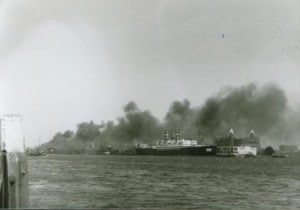 The Wilhelmina Kade in Rotterdam and headquarters of the company. It saw some of the fiercest fighting in the whole port of Rotterdam. During subsequent bombardments most of the facilities were destroyed and only the head office at the head of the pier survived.
The Wilhelmina Kade in Rotterdam and headquarters of the company. It saw some of the fiercest fighting in the whole port of Rotterdam. During subsequent bombardments most of the facilities were destroyed and only the head office at the head of the pier survived.
On 10 May 1940, Nazi-Germany invaded the Netherlands and it ended the Dutch neutrality. All the company’s ships were now taken up by the government to help with the war effort. That is, most of the ships, as a few were stranded in Rotterdam at the outbreak of the war and could not get out anymore. As mentioned before the Statendam was caught in the fighting in the port of Rotterdam and burnt out. The cargo ship Boschdyk and the intermediate liner Veendam fell in German hands.
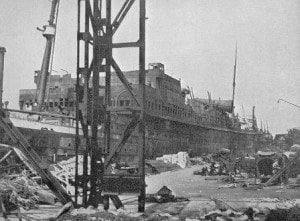 The burnt out hull of the Statendam III and the adjacent warehouses reduced to rubble.
The burnt out hull of the Statendam III and the adjacent warehouses reduced to rubble.
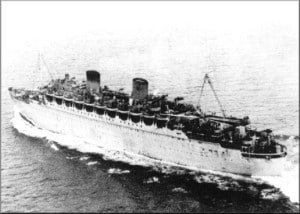 Sailing full speed with a full house of troops.The ship was called “one of the seven monsters” referring to the fact that she was one of the ships with a very large troop capacity.
Sailing full speed with a full house of troops.The ship was called “one of the seven monsters” referring to the fact that she was one of the ships with a very large troop capacity.
The Nieuw Amsterdam, as most other passenger ships, was converted into a troopship and able to carry close to 9000 troops. She spent most of the war in the Far East but was relocated to the North Atlantic in 1945. As far as G.I’s could wing it, or their commanding officers, they tried to sail on the HAL hips, as these were known to offer three meals a day. Other company’s often limited themselves to two, due to the logistics involved. To give an idea where everybody slept, the indoor First Class swimming pool took 64 G.I’s sleeping in standee bunks 5 high. Junior officers slept up to four in a cabin, senior officers two to a suite and only Sr. Commanding Officers could expect an own cabin. These crowded conditions resulted in a space ratio of 4.
The ship came through the war unscathed and it was noted that by then she had steamed 530.452 miles and carried 378.361 troops. Only the Queen Mary and the Queen Elizabeth had carried more and those ships were more than DOUBLE the size of the Nieuw Amsterdam.
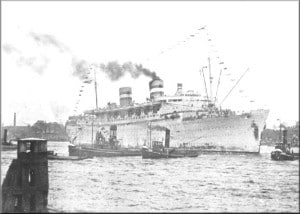 The Nieuw Amsterdam II steaming up the Nieuwe Waterweg on the way home with the crew lining the railings. Most of them had been away from home for more than six years.
The Nieuw Amsterdam II steaming up the Nieuwe Waterweg on the way home with the crew lining the railings. Most of them had been away from home for more than six years.
Although the war ended for The Netherlands on 10 May 1945, it would take another 11 months, until 10 April 1946, before the Nieuw Amsterdam would come home. She arrived still in wartime grey but with the funnels already repainted in the company’s colors denoting that she was back under company control. Some newspapers reported that when the ship sailed into Rotterdam more than 600.000 people were lining the dykes. If this were to be true than that would have meant that 10% of the Dutch population came to see this arrival.
Whatever might be true, for the people of Rotterdam it meant that the war was now REALLY over and that the rebuilding of the city and the port could start. The ship was involved in carrying troops and war brides for a period and was not released from war duty completely until 1947. Then she was sent back to her builders for a refit which basically meant a complete rebuilding of the interiors. Most of the loose items had been taken out during the refit into a troopship but not all of it had survived the war in good condition. Thus much had to be replaced, movable interior parts as well as items that were nailed or screwed into the ship.
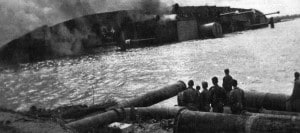 The Zuiderdam, last in a series of four medium seized passenger cargo liners (Noordam, Zaandam, Westerdam, Zuiderdam) never saw commercial service.
The Zuiderdam, last in a series of four medium seized passenger cargo liners (Noordam, Zaandam, Westerdam, Zuiderdam) never saw commercial service.
Not all ships survived the war. The Zuiderdam, supposed to be the fourth addition to the Noordam class of 1938, was first sank in the building dock during construction in 1941 by the Dutch Resistance. After being raised in 1942 she was sunk by the Germans as a blockade ship and burnt out in the process. She was one of several ships that the occupier used to block the Dutch port entrances to prevent an allied invasion. After the war the hull was raised again and scrapped. The hull had been damaged too much to make repairs worthwhile. Her sister the Westerdam was also sank during construction but could be repaired and entered service in 1947. She was the first postwar HAL passenger ship that entered New York with commercial intent.
During the war 165 Hal employee’s had lost their lives at sea; 43 had perished in the German concentration or labor camps and 56 had died outside occupied territory. At 10 May 1940 the fleet had consisted of 20 ships sailing and two under construction in 1945 there were only 10 left. Nearly all the company’s property at the Wilhelminakade and the Rijnhaven had been destroyed; only the main office at the end of the pier had miraculously survived.
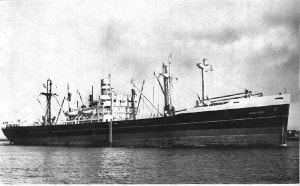 The Aagtedyk was one of the 10 Victory-class ships that the company bought and named the A-class.
The Aagtedyk was one of the 10 Victory-class ships that the company bought and named the A-class.
Holland America had to invest extensively to be able to return to its prewar status and to service all its pre war routes. Surplus cargo ships of the Liberty and Victory class were bought. Not longer needed now the war was over, they helped to get the worlds trade back on its feet and get the shipping companies going again.
The largest group bought were the Victory ships. They were called the A-class with names like Aagtedyk, Akkrumdyk, Aalsdyk, Axeldyk etc. They remained with the company until the mid sixties; when they were replaced by more modern ships. They served on routes to the East and West coast of the USA and Canada and to South America. In three years time 19 ships were added to the fleet, which stood in 1949 at 27 vessels with a total of 256.362 Brt.
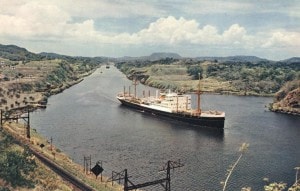 The Dalerdyk of the West Coast service. These ships were not very big, so please note the width of the Panama Canal in the 1950’s. No wonder it’s nickname used to be the Big Ditch
The Dalerdyk of the West Coast service. These ships were not very big, so please note the width of the Panama Canal in the 1950’s. No wonder it’s nickname used to be the Big Ditch
While the big passenger ships of the company sailed on the North Atlantic, there were several smaller ships that took passengers all the way to Vancouver on the West Coast of Canada, travelling via the Panama Canal. Before air travel, it was for businessmen a good way to get there, as one could also conduct business in Middle America if taking the whole voyage. These ships were very well loved and nearly always sailing full. They carried 30 passengers in first class accommodation and this West Coast service lasted from 1929 to 1963. Then it was not longer possible to compete against the airplanes and the service became cargo only.
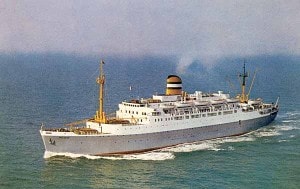 The Maasdam of 1951 sailing in the North Sea. With her sister she brought a new concept to the North Atlantic that of placing emphasis on the Tourist Class capacity.
The Maasdam of 1951 sailing in the North Sea. With her sister she brought a new concept to the North Atlantic that of placing emphasis on the Tourist Class capacity.
With the upswing of the economy around 1950, there was a steep increase in the demand for trans Atlantic crossings, especially cheap ones. The company responded by converting two cargo hulls that were under construction into small size passenger ships. The Maasdam (III) and Ryndam (II) were only 16.000 tons in volume, had single screw propulsion and carried 39 passengers First class and 854 in Tourist class. Space ratio 18.8. . The novelty of these ships was that they restricted the first class to the top deck area and gave the tourist class the run of the rest of the ship. Also they were the first ships that sported the company’s new livery; the grey hull.
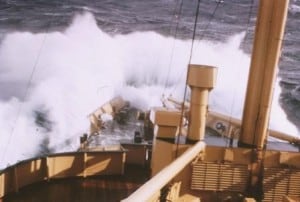
This was still before the age of stabilizers, whose presence on the North Atlantic only became common in the mid 50’s, so these little ships rocked and rolled their way across the NA in summer and winter with utter disregard for their human cargo inside. Here we see the Maasdam plowing through typical North Atlantic weather.
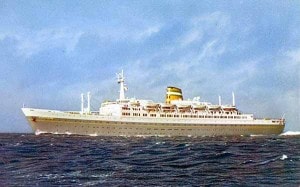 1957 saw the arrival of the Statendam IV.
1957 saw the arrival of the Statendam IV.
The Maasdam and Ryndam concept was very successful, so successful that the company planned a bigger version. At the same time it had sufficient funds to start thinking about a running mate for the Nieuw Amsterdam. As this was going to be the Ship of State again for the Netherlands, a number of idea’s that were being developed for this new ship were going to be tried out first on the Statendam of 1957. This included the fitting of stabilizers. Also the tourist class concept was further developed on this ship. Again restricting the first class to the two upper decks. As the airplane took more and more business away from the North Atlantic ships, the Statendam was also designed with off-season cruising very much in mind. As a matter of fact, she made the first world cruise (*) for the company. With a tonnage of 25.000 GRT she carried 84 first and 871 tourist class. It gave her a space ratio of 25.9 (*) The first real company world cruise was made with the Ryndam (I) in 1927 but it was as a charter. It sailed as a floating university.
For a better look at the ship: please use this U tube link: http://www.youtube.com/watch?v=w5BZHPx_bv8&feature=related
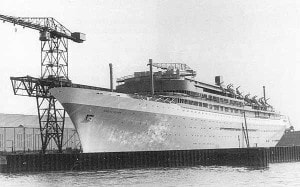 The Rotterdam V at the fitting out quay.
The Rotterdam V at the fitting out quay.
The ss Rotterdam of 1959 was the postwar Dutch Ship of State. For a ship of state she was much smaller than her British, French or Italian compatriots. This as she had to make money and survive without governmental help. She was very un-traditional as there were no funnels; just two smoke stacks and the two-class system was horizontal in layout. The standard of sub-division until that time had been First Class in the center of the ship, 2nd class near the stern and 3rd or tourist class in the bow area. Such a division, with separate -class- staircases, made it very difficult to combine areas. The company decided for an horizontal layout and so the whole ship could be opened up to all guests when cruising, which was with HAL a one class affair. To achieve this, two decks of public rooms were created and they could be combined or separated as needed. For the North Atlantic Class service, there was a very clever system with separation doors in the corridors that made it possible to vary the size of the first and the tourist class. So a small first class cabin could be sold as an upscale tourist class cabin if the need arose or vice versa.
The Rotterdam measured 39,647 tons. Had a length of 748 feet and carried a maximum of 647 in First class and a minimum of 809 Tourist class. Due to this separation door system, the class figures varied from crossing to crossing. When cruising, the maximum had been set on 800 when designed. The space ratio: 27.2 on the North Atlantic and 49.6 when cruising. In her later years she would carry about 1100 maximum when cruising and that gave her a space ratio of 36.
The keel was laid on 14 December 1956 and she was launched on the 13th of September 1958 by the Queen Juliana, in the same way that her mother had launched the Nieuw Amsterdam. The maiden voyage commenced on 3 September 1959 with a trans atlantic crossing to New York.
Here some footage of the christening on U-tube.
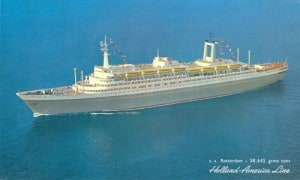 The ship as seen upon delivery. A scan taken from a company poster.
The ship as seen upon delivery. A scan taken from a company poster.
The ship came into service in the year that the airplanes carried as many passengers through the air as the passenger ships over sea. From then on the trans atlantic ships would carry less and less each year. This caused in later years a number of well known ships, such as the Queen Mary, Queen Elizabeth and United States to be retired. As they were designed for the North Atlantic liner service only and thus not suitable for cruising. A dual-purpose built ship as the Rotterdam could still make a good living by making more and more cruises and did outlast all of her rivals.
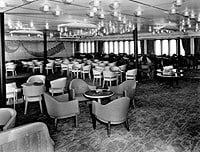
The interiors of the Rotterdam were of a very functional design with the use of a lot of different woods and integrated artwork by contemporary Dutch artists. Above the Queens lounge. This was during the North Atlantic service the main dance lounge for the Tourist class.
The diningrooms were located deep in the hull of the ship on B deck. The First and Tourist class dining rooms were on the same deck and placed opposite. The two were separated by an intertwining staircase with partitioning walls, so that on North Atlantic cruises the two classes could be separated. When cruising these walls would slid into the bulkheads and both dining rooms would be accessible for everybody.
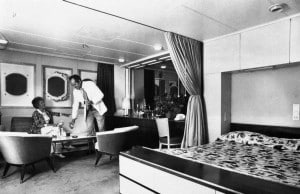
Here a First class suite located on the Lower promenade deck amidships. These suites came with the option of a little inside cabin opposite the Suite entrance door, so that the well to do clientele could bring their own servant and have him/her live right across. These servants would have all the first class amenities but would eat in a wing of the dining room slightly separated from their patrons.
I found on U tube in two parts, a HAL promotional film aimed at the dutch public, about life on board.
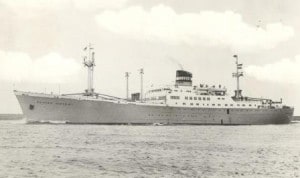 The Prinses Margriet was taken over from the Oranje Lijn, a Dutch company specializing in services to the Great Lakes.
The Prinses Margriet was taken over from the Oranje Lijn, a Dutch company specializing in services to the Great Lakes.
After the introduction of the Rotterdam, the company started to invest more in the cargo business. Join ventures were set up to extend the cargo network and as a result of one of those ventures, the company found itself in the ownership of this little passenger -cargo ship, called the Prinses Margriet. As she was named after the Patron of the Dutch Merchant fleet, she was not renamed. 9400 tons in size and carrying 111 passengers on services from Rotterdam to the Great Lakes and the Caribbean. She remained with the company for a number of years and was then sold to the little island of Nauru in the Pacific.
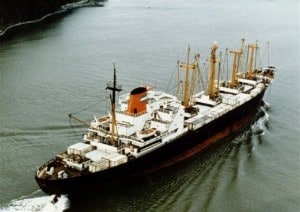 One of the conventional cargo ships of the company built in the mid sixties, the Moerdyk.
One of the conventional cargo ships of the company built in the mid sixties, the Moerdyk.
On the photo the ship is approaching the Golden Gate Bridge in San Francisco. As we can see the ship is already carrying containers, a sign of the future to come. These ships required a high number of crew to operate all the conventional machinery and cargo gear on board and the docking times were long. Loose cargo, even when stacked on pallets, take long to offload and is very labor intensive. These conventional cargo ships disappeared quickly from the regular liner service, the moment the full container ships arrived. One containership could do the work of five of these conventional ships, with a third of the crew and only be in port for a 10th. of the time.
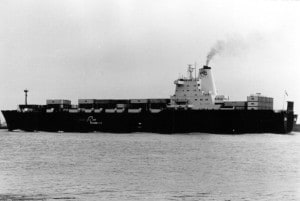 The Atlantic Crown, capable of 25 knots, she sailed on the Express service of the ACL on the North Atlantic.
The Atlantic Crown, capable of 25 knots, she sailed on the Express service of the ACL on the North Atlantic.
With the containerization of the cargo world becoming more and more the norm, Holland America had to do something in order not to be left behind. However containerships were expensive to built and a complete new sort of infrastructure was needed. As the competition faced the same challenge a joint venture was formed with the British Cunard line, the French line (both big rivals in the passenger trade of the past) and some Scandinavian company’s. It was decided not to go for containers only but also to carry rolling stock. Thus the ships were going to be of the Container Ro-Ro type. Containers in the forward holds and on deck; Cars, Trucks and anything else that rolled in a big garage accessible via a ramp in the stern.
In 1967 they formed the Atlantic Container Line or ACL. Each company brought in two ships, one slow one and one for the express service. Here we see the Atlantic Crown, which could carry 850 containers of 20 feet length and 834 standard size cars. The route was from Hamburg via Rotterdam or Antwerp to various ports on the American east coast. With the “slow” service calling at more ports than the “fast” service.
Around the same time Holland America entered into another joint venture; again with an old adversary from the North Atlantic days. Together with Hapag – Lloyd (A combination of the old North German Lloyd and the Hamburg America Line) two LASH ships or the Lighter Aboard SHips were built. Each ship would load big barges, transport them over the ocean, unload them and then a tug would push the barges upriver to their destination. This way grain, ore and paper could be carried and the quick loading system would reduce the time a ship would have to spend in port.
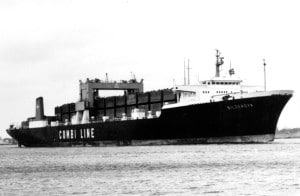 The only Lash ship ever to sail under the Dutch flag, the Bilderdyk (II) of 1971. The name Combi-Line on the hull indicates the name of the joint service in which she operated.
The only Lash ship ever to sail under the Dutch flag, the Bilderdyk (II) of 1971. The name Combi-Line on the hull indicates the name of the joint service in which she operated.
This ship was 36.000 tons in size, 855 feet long and carried 83 barges. Each had a content of 45,000 cub. Feet. She was built in 1971 and survived until the autumn 2008. Sailing most ofher career for an American Paper mill company between Savannah and Europe.
PLEASE CONTINUE TO PART FOUR.

February 5, 2014 at 7:05 pm
Did Holland America ever cruise the Caribbean in the 1960’s? We travelled from New York to Rotterdam on the Statendam in December 1963 and we wondered where the ship had been before we boarded her.
October 20, 2015 at 12:54 pm
I sailed from New York to Rotterdam in the fall of 1958 (5-10 days after Sept. 1st).
I was traveling with a student group (about 100 people) ex Chicago called Institute of European Studies.
Can you tell me the name of the ship we sailed on?
Your help appreciated.
Ed Heath
October 20, 2015 at 3:45 pm
Good morning,
Thank you for reading my blog. that is difficult to answer as several ships used to carry larger groups at the end of the season and IES was a very frequent organiser with HAL.
You might still remember a few things, if you remember a white hull than you sailed with the Groote Beer (Emigrants out, students in) If you remember a grey hull then it was either the ryndam or the Maasdam from 1951. On bot these three ships you would have most likely gotten sea sick as they were designed as cargo ships. If you remember a ship with two yellow funnels then you were on the Nieuw Amsterdam. I have not yet collected/ transcribed all the sea voyages of Holland America in 1958, so I can not yet go by the exact date alone. I hope this helps.
Best regards
Capt. Albert
May 19, 2021 at 5:40 pm
Captain Albert,
I am writing my second book on Lee Harvey Oswald. He wrote several political essays in the library of the Maasdam in June 1962. I am looking for a photo of the library circa 1962. Thank you!
November 9, 2015 at 4:30 pm
Good day, I know this is not the right place but I am desperate.
I am Arie Tiele from the Netherlands and a modelbuilder
I have 19 wooden ships on large scale mostly radio controlled.
I am planning to build a 1:100 scale model of the Statendam III (build 1922 at Harland & Wolff
I have all the drawings from the Maritime Museum Rotterdam but I miss the most crucial
The ribs plan
I have contact Harland & Wolff, Wilton Feyenoord, the Ulster transport museum in Ireland and Greenwich at Baltimore.
All without success
Can someone please help me finding these ribs plan?
Cost will be covered.
Kindly regards
Arie Tiele
November 9, 2015 at 6:27 pm
Thank you for reading my blog.
But I am afraid that I can not help you here. When I was at the Ulster Transport Museum they had an awful lot of construction drawings but I do not know if they had everything ready on file or whether you had to visit the Reading room yourself and sift through it.
The only thing I can think of is to see if there is not another ship with the same specs. H&W built ships fairly standard for various company’s in the same way Fincantieri in italy now does for the cruise industry. Around the time of the century the HAL ships were quite identical in construction to the smaller White Star Line ships, Atlantic Transport etc.
Best regards
Capt. Albert
July 29, 2017 at 11:02 am
I am very confused. I believe I sailed to Rotterdam in December 1957 on the SS Rotterdam? Lionel Hampton and his band were aboard, they entertained on their way to tour Europe. I traveled in a very inexpensive class, shared a room with 3 other girls. I paid $177.00 for my fare. It was so very long ago, I was quite young, am I not remembering correctly?
August 3, 2017 at 7:53 am
Thank you for reading my blog.
This is a difficult one, so I had to do some digging but I can not find any records inside HAL. The lionel hampton biographies speak about several european tours. The most famous ones were 1953, 1956,1957, 1958 and then in the 60’s again. In 1957 he visited and played in Holland and Germany and England. If you met him in 1957 then it can not have been on the Rotterdam as that ship was still being built, it can not have been on the Statendam and Nieuw Amsterdam as in December 1957 they were making cruises. Hampton most of the time toured Europe in October and November, so I wonder if it was not in December that you took the cruise but in November as both the Statendam and Nieuw Amsterdam made a trans atlantic crossing.
I hope this helps
Best regards
Captain Albert
August 12, 2017 at 8:42 pm
Sailed Summer 1959, Great Lakes to Europe, believe it was on the Rotterdam.
Could you please clarify?
Passenger list? Travelled with Mae Burnham.
August 15, 2017 at 6:10 am
Good morning,
thank you for reading my blog. I need a little bit more information before I can even confirm which voyage you were on. The ss Rotterdam came into service in august 1959. But it only sailed from New York. So if you sailed from the Great Lakes, you must have travelled to New York First. We had ships sailing from Montreal / Quebec near the St. Lawrence seaway.
If you remember dates, I can maybe do something, but the for the moment the information in your comment contradict with the ships name.
Best regards
Capt. Albert
October 4, 2017 at 5:32 pm
I just found out that my Opa & Oma travelled on the Ryndan in January of 1953 when they immigrated to Canada from the Netherlands. They went through Pier 21 in Halifax.
Can you point me to where I can find the passengers lists? And I would also love some pictures of the ship and its passengers.
Thank you.
August 5, 2019 at 6:23 pm
Hi Captain Albert,
Do you know which was the last ship with mail on board that left from Rotterdam to New York before May 10, 1940.
Kind regards
August 6, 2019 at 8:02 am
Thank you for reading my blog.
As far as my records go, it was the Delfdyk who left on the day of the invasion. On board 22 passengers, some gold from the Dutch bank and an unknown quantity of mail. I do not know if this mail was purely governmental or also private mail.
I hope this helps.
Best regards
Capt. Albert
December 30, 2021 at 3:39 pm
Dear Captain Albert,
Dear Captain Albert,
Thank you for your wonderful blog. We have learned so much from you. Esther Shaya and I are writing about Wim ten Broek, who designed what is perhaps the most famous HAL poster. Wim was in the Resistance in WWII, and we now think that HAL did some Resistance work too. We’d love to talk to you about this subject if you have time.
Thank you very much
Dawn Skorczewski, PhD
January 2, 2022 at 2:03 pm
Good afternoon,
thank you for your comment. I do not know of any relation of HAL directly to the resistance as the company leaders were all in England and the USA but a lot of Hal personnel who were stuck in Holland were directly involved in the resistance. If you look under captains from the past on my blog and go to Captain Filippo you will find that he ran a complete underground bank which paid families of Dutch merchantmen at sea, and the Occupational forces never found out about him. Then there is Captain Timmermans (biography still coming) who was involved in arresting Germans, carrying out crossings through no-mans land and other derring-do. 261 HAL personnel (about 10% of employed staff in 1940) lost their lives, either at sea or during the occupation. If you need more information, please contact me on Captalbert1@aol.com
Best regards
Capt.Albert